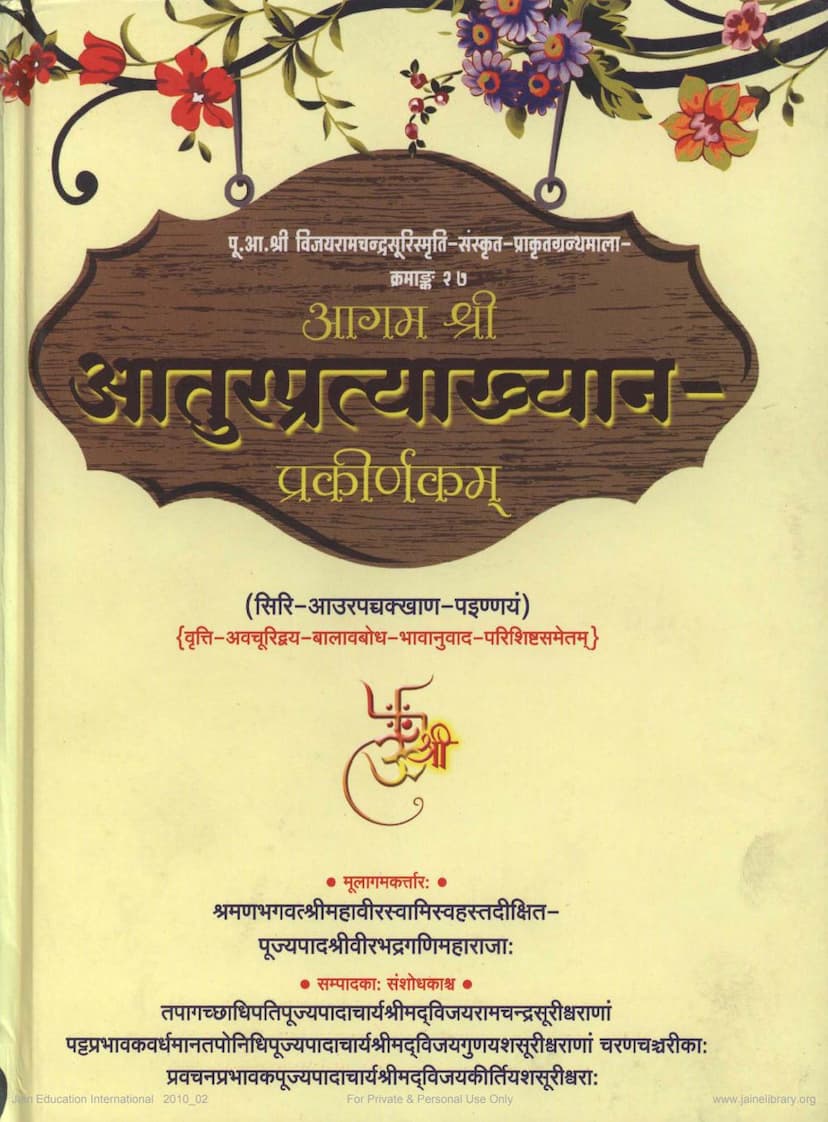Agam 25 Prakirnak 02 Atur Pratyakhyan Sutra
Added to library: September 1, 2025

Summary
The provided Jain text is the Ātur Pratyākhyān Prakīrṇaka Sūtra (also known as Āturapratyākhyāna Prakeṇṇaka in Sanskrit), which is part of the Jain Agamas, specifically within the Prakirṇaka (miscellaneous) category. This particular text (Agam 25, Prakirṇaka 02) is numbered 27 in the collection "Pū. Ā. Śrī Vijayarāmacandrasūri Smṛti-Saṁskṛta-Prākṛta-Granthamālā" published by Sanmarg Prakashan. The original author of the Agama is believed to be Śramaṇa Bhagavān Śrī Mahāvīrasvāmi's disciple, Pūjyapāda Śrī Vīrabhadra Gaṇi Mahārāja.
This volume is a comprehensive compilation, including:
- The original Agama text.
- Commentaries (Vr̥tti and Avacūri).
- A simpler explanation (Bālāvodha).
- A devotional translation (Bhāvānuvāda).
- Appendices (Pariśiṣṭa).
Key aspects and content of the Ātur Pratyākhyāna Pratijñā Sūtra, based on the provided summary and introductory sections:
-
Title and Context: The text is about "Ātura Pratyākhyāna," which translates to the "Renunciation of the Sick" or "Vow of the Afflicted." This suggests the text deals with the spiritual practices and vows undertaken by individuals who are ill or nearing the end of their lives, in a state of distress or urgency.
-
Author and Lineage: The root text is attributed to Śrī Vīrabhadra Gaṇi, a disciple of Lord Mahāvīra. The present published version is compiled and edited by the scholars of the Tapagachcha tradition, specifically mentioning Śrī Vijayakīrti Yaśasūrīśvara and others, in memory of Ācārya Śrī Vijayarāmacandra Sūriśvara.
-
Purpose and Significance: The text is considered a crucial guide for attaining spiritual merit and peace, especially during times of illness or facing death. It emphasizes the importance of proper renunciation and vows (pratyākhyāna) during such critical phases to achieve positive outcomes in the cycle of rebirth and ultimately liberation (moksha). The introduction highlights that such Agama texts are like a strong raft for crossing the ocean of worldly existence.
-
Content Summary from the Introduction (Prāstāvik):
- Definition of Āgama: The text begins by defining Āgama as the teachings of Jina, compiled by Ganadharas and perfected by Śrutadharas, which are essential for crossing the ocean of existence.
- Prakirṇaka Literature: It identifies the Āgamas as being divided into Anga, Upanga, Chedasūtras, Mūlasūtras, Culikā Sūtras, and Panna Sūtras. The ten Panna Sūtras are also known as Prakirṇaka.
- Origin of Prakirṇaka: It mentions that the Prakirṇaka texts are considered to be the collected essence of the teachings, compiled by disciples of each Tirthankara.
- Ātura Pratyākhyāna Prakīrṇaka: This text is the second in the sequence of Prakirṇakas.
- Author of the Agama: Attributed to Śrī Vīrabhadra Gaṇi, a disciple of Lord Mahāvīra, who compiled the teachings of Lord Mahāvīra.
- Ancient Origin: The text is over 2500 years old, originating from the time of Kevalajñānīs and Chaturdaśapūrvadharas.
- Definition of Ātura: The text defines an Ātura as a practitioner who is approaching the final moments of life, where medical intervention is no longer effective, and one must accept death with equanimity.
- Pratyākhyāna: It defines Pratyākhyāna as specific vows or renunciations undertaken by such an afflicted person, involving the acceptance of fourfold refuge, atonement for past deeds, and commendable actions.
- Meaning of the Title: The title Ātura Pratyākhyāna Prakīrṇaka is appropriate because it describes the renunciation undertaken by the afflicted (Ātura).
- Connection to Chaturasharana: The author, Vīrabhadra Gaṇi, did not create a new invocation but rather connected it to the invocation made in the Chatuhśaraṇa Prakīrṇaka, suggesting a direct relationship.
- Content Breakdown: The text begins by discussing the concept of "Bāla Paṇḍita Maraṇa" (death of a wise child), which applies to a householder who has accepted partial vows (deśavirati). It explains the twelve vows of a householder and then delves into the details of Paṇḍita Paṇḍita Maraṇa (death of a wise person who has taken full vows).
- Key Concepts in Pandita Maraṇa: It details the process of renunciation, including confessing sins, accepting penance, observing the five Mahāvratas, practicing equanimity, renouncing attachment to the body, and meditating on the soul.
- Classification of Death: The text differentiates between three types of death: Bāla (ignorant), Bāla Paṇḍita (wise child/partially wise), and Paṇḍita (wise) death. It explains the results of each, emphasizing that Paṇḍita death leads to auspicious rebirths and quicker liberation.
- Sixty-three Types of Dhyāna (Meditations): A significant part of the text discusses sixty-three types of negative or impure meditations (dur-dhyāna) that lead to negative consequences. These are presented with illustrative examples from Jain lore, helping practitioners identify and avoid them. The introduction suggests that the author possessed profound insight into human psychology to identify these states.
- Structure of the Publication: The volume is divided into three main sections:
- Khanda-1: Contains the Vr̥tti by Acharya Bhuvanatungasuri, Avacūri by Acharya Somasundarasuri, and another Avacūri by Acharya Gunaratnasuri.
- Khanda-2: Includes a compilation of illustrative stories related to the sixty-three Dhyānas mentioned in the Prakīrṇaka.
- Khanda-3: Contains various appendices, including a simple explanation (Bālābodha), devotional translation (Bhāvānuvāda), a shorter version (Laghu Ātura Pratyākhyāna), collection of illustrative stories for the sixty-three Dhyānas, an index of the original verses, and a comparative analysis with Digambara texts like Mūlācāra.
-
Commentaries: The text is enriched with multiple layers of commentary, indicating its importance and the need for detailed explanation. The commentaries by Ācāryas Bhuvanatungasuri, Somasundarasuri, and Gunaratnasuri highlight the scholarly depth and effort in preserving and explaining these ancient teachings.
-
Thematic Focus: The core theme revolves around the spiritual preparation for death and the attainment of a favorable rebirth or liberation, achieved through understanding and practicing specific vows and meditations, particularly focusing on the concept of Paṇḍita Maraṇa. It also stresses the importance of understanding negative mental states (dhyānas) to avoid them and cultivate positive ones.
In essence, the Ātura Pratyākhyāna Prakīrṇaka Sūtra is a profound Jain scripture offering guidance on how to face the end of life with spiritual preparedness, focusing on virtuous conduct, renunciation, and meditative practices to ensure a positive outcome and progress on the path to liberation.